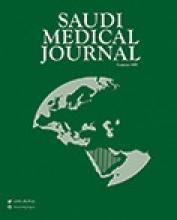Abstract
OBJECTIVE: A pilot study to estimate the prevalence of osteopenia and osteoporosis in postmenopausal Saudi women.
METHODS: Lumbar spine bone density was measured in 830 postmenopausal Saudi women 50-80 years of age (average 59 years), using dual x-ray absorptiometry (DXA) at the King Khalid University Hospital, Riyadh, Kingdom of Saudi Arabia between 1989 and 1999.
RESULTS: The results of the bone mineral density (BMD) in gm/cm2 were compared to the peak bone density (PBD) in healthy young women (T-score). Based on the definition of World Health Organization (WHO), the T-score value was considered for analysis. Accordingly, 248 (29.9%) subjects showed normal result, mean BMD of 1.117 +/- 0.13 and T-score of -0.66 SD; while 254 (30.6%) subjects showed osteopenia, mean BMD of 0.983 +/- 0.11 and T-score of -2.4 SD and 328(39.5%) subject showed osteoporosis, mean BMD of 0.767 +/- 0.11 and T-score of -3.4 SD. When the 830 subjects were analyzed by decades, there were 42.3% normal, 33.4% osteopenia and 24.3% osteoporosis in age 50-59 years; 11% normal, 27% with osteopenia and 62% with osteoporosis in age 60-69 years while in older age 70-79 years only 4.6% had normal BMD, 21.5% had osteopenia and 73.8% had osteoporosis.
CONCLUSION: Osteopenia and osteoporosis are common among postmenopausal Saudi women and should be considered as a matter of public health. Bone densitometry should be used to assess the severity of bone loss, identify those who need therapy and for follow up and early diagnosis of those with osteopenia in order to institute proper therapy and avoid future osteoporosis.
- Copyright: © Saudi Medical Journal
This is an open-access article distributed under the terms of the Creative Commons Attribution-Noncommercial-Share Alike 3.0 Unported, which permits unrestricted use, distribution, and reproduction in any medium, provided the original work is properly cited.






